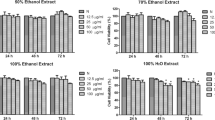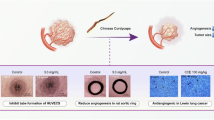Abstract
Propolis, obtained from honeybee hives, has been used in Oriental folk medicine as an antiinflammatory, anti-carcinogenic, and immunomodulatory agent. There is considerable evidence suggesting that angiogenesis and chronic inflammation are codependent. Blockage of angiogenesis results in an anti-inflammatory effect. Ethanol (EEP) and ether extracts of propolis (REP), and caffeic acid phenethyl ester (CAPE), an active component of propolis, were examined for their anti-angiogenic activities using the chick embryo chorioallantoic membrane (CAM), and the calf pulmonary arterial endothelial (CPAE) cell proliferation, assays. The presence of EEP, REP and CAPE inhibited angiogenesis in the CAM assay and the proliferation of CPAE cells. The results suggest that anti-angiogenic activities of EEP, REP and CAPE are also responsible for their anti-inflammatory effect.
Similar content being viewed by others
References
Arsenault, A. L., Lhotak, S., Hunter, W. L., Banquerigo, M. L., and Brahn, E., Taxol involution of collagen-induced arthritis: ultrastructural correlation with the inhibition of synovitis and neovascularization.Clin. Immunol. Immunopathol., 86, 280–289 (1998).
Bankova, V. S., de Castro, S. L., and Marcucci, M. C., Propolis: recent advances in chemistry and plant origin.Apidologie, 31, 3–15 (2000).
Christenson, L. K., and Stouffer, R. L., Proliferation of microvascular endothelial cells in the menstrual cycle and stimulated early pregnancy.Endocrinology, 137, 367–374 (1996).
Cizmarik, J., and Matel I., Examination of the chemical composition of propolis I. Isolation and identification of the 3,4-dihydroxycinnamic acid (caffeic acid) from propolis.Experientia, 26, 713 (1970).
Crum, R., Szabo, S., and Folkman, J., A new class of steroids inhibits angiogenesis in the presence of heparin fragment.Science, 230, 1375–1378 (1985).
Dimov, V., Ivanovska, N., Bankova, V., and Popov, S., Immunomodulatory action of propolis: IV. Prophylactic activity against gram-negative infections and adjuvant effect of the water-soluble derivative.Vaccine, 10, 817–823 (1992).
Dobrowolski, J. W., Vohora, S. B., Sharma, K., Shah, S. A., Naqvi, S. A., and Dandiya, P.C., Antibacterial, antifungal, antiamoebic, anti-inflammatory and antipyretic studies on propolis bee products.J. Ethnopharmacol., 35, 77–82 (1991).
Eley, B. M., Antibacterial agents in the control of supragingival plaque-a review.Br. Dent. J., 186, 286–296 (1999).
Firestein, G. S., Echeverri, F., Yeo, M., Zvaifler, N. J., and Green, D. R., Somatic mutations in the p53 tumor suppressor gene in rheumatoid arthritis synovium.Proc. Natl. Acad. Sci. U.S.A., 94, 10895–10900 (1997).
Firestein, G. S., Starving the synovium: angiogenesis and inflammation in rheumatoid arthritis.J. Clin. Invest., 103, 3–4 (1999).
Grange, J. M., and Davey, R. W., Antibacterial properties of propolis (bee glue).J. R. Soc. Med., 83, 159–160 (1990).
Greenaway, W., May, J., Scaysbook, T., and Whatley, F. R., Identification by gas chromatography-mass spectrometry of 150 compounds in propolis.Z. Naturforsch., 46c, 111–121 (1991).
Grunberger, D., Banerjee, R., Eisinger, K., Oltz, E. M., Efros, L., Caldwell, M., Estevez, V., and Nakanishi, K., Preferential cytotoxicity on tumor cells by caffeic acid phenethyl ester isolated from propolis.Experientia, 44, 230–232 (1988).
Guarini, L., Su, Z. Z., Zucker, S., Lin, J., Grunberger, D., and Fisher, P. B., Growth inhibition and modulation of antigenic phenotype in human melanoma and glioblastoma multiforme cells by caffeic acid phenethyl ester (CAPE).Cell Mol. Biol., 38, 513–527 (1992).
Jeffrey, R. J., Michael, P. S., Charles, H. K., Derek, A. W., and James, D. W., The codependence of angiogenesis and chronic inflammation.FASEB, 11, 457–465 (1997).
Krol, W., Czuba, Z., Scheller, S., Gabrys, J., Grabiec, S., and Shani, J., Anti-oxidant property of ethanolic extract of propolis (EEP) as evaluated by inhibiting the chemiluminescence oxidation of luminol.Biochem. Int., 21, 593–597 (1990).
Marcucci, M. C., Propolis: chemical composition, biological properties and therapeutic activity.Apidologie, 26, 83–99 (1995).
Mirzoeva, O. K., Yaqoob, P., Knox, K. A., and Calder, P. C., Inhibition of ICE-family cysteine proteases rescues murine lymphocytes from lipoxygenase inhibitor-induced apoptosis.FEBS Lett., 396, 266–270 (1996).
Natarajan, K., Singh, S., Burke, T. R. Jr., Grunberger, D., and Aggarwal, B. B., Caffeic acid phenethyl ester is a potent and specific inhibitor of activation of nuclear transcription factor NF-kappa B.Proc. Natl. Acad. Sci. U.S.A., 93, 9090–9095 (1996).
Oikawa, T., Hirotani, T., Nakamura, O., Shudo, K., Hiragum, A., and Iwaguchi, T., A highly potent antiangiogenic activity of retinoids.Cancer Lett., 48, 157–162 (1989).
Park, E. H., and Kahng, J. H., Suppressive effects of propolis in rat adjuvant arthritis.Arch. Pharm. Res., 22, 554–558 (1999).
Peacock, D. J., Banquerigo, M. L., and Brahn, E., Angiogenesis inhibition suppresses collagen arthritis.J. Exp. Med., 175, 1135–1138 (1992).
Scheller, S., Wilczok, T., Imielski, S., Krol, W., Gabrys, J., and Shani, J. Free radical scavenging by ethanol extract of propolis.Int. J. Radial Biol., 57, 461–465 (1990).
Serkedjieva, J., Manolova, N., and Bankova, V., Anti-influenza virus effect of some propolis constituents and their analogues (esters of substituted cinnamic acids).J. Nat. Prod., 55, 294–302 (1992).
Song, Y. S., Park, E. H., Hur, G. M., Ryu, Y. S., Lee, Y. S., Lee, J. Y., Kim, Y. M., and Jin, C., Caffeic acid phenethyl ester inhibits nitric oxide synthase gene expression and enzyme activity.Cancer Lett., 175, 53–61 (2002).
Starzyk, J., Scheller, S., Szaflarski, J., Moskwa, M., and Stojko, A., Biological properties and clinical application of propolis. II. Studies on the antiprotozoan activity of ethanol extract of propolis.Arzneimittelforschung, 27, 1198–1199 (1977).
Steinberg, D., Kaine, G., and Gedalia, I., Antibacterial effect of propolis and honey on oral bacteria.Am. J. Dent., 9, 236–239 (1996).
Author information
Authors and Affiliations
Corresponding author
Rights and permissions
About this article
Cite this article
Song, Y.S., Park, EH., Jung, K.J. et al. Inhibition of angiogenesis by propolis. Arch Pharm Res 25, 500–504 (2002). https://doi.org/10.1007/BF02976609
Received:
Issue Date:
DOI: https://doi.org/10.1007/BF02976609




